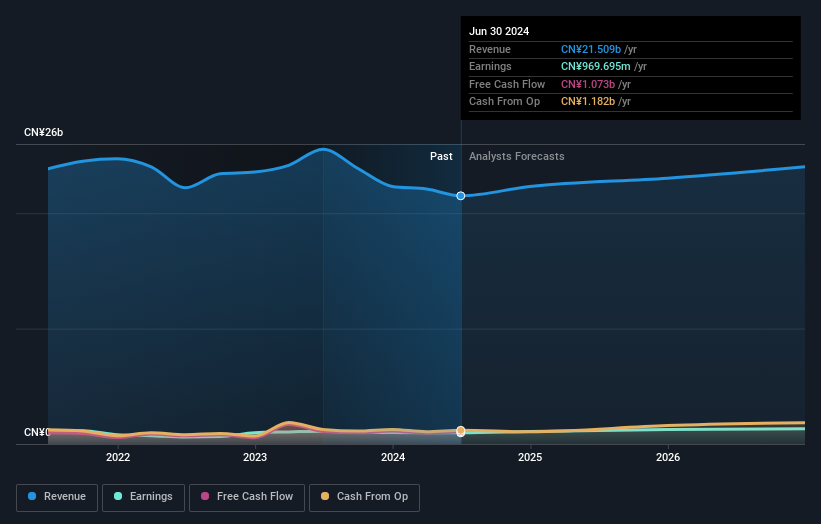Shanghai Mechanical & Electrical Industry Co.,Ltd.'s (SHSE:600835) biggest owners are public companies who got richer after stock soared 5.0% last week
Key Insights
- Significant control over Shanghai Mechanical & Electrical IndustryLtd by public companies implies that the general public has more power to influence management and governance-related decisions
- A total of 3 investors have a majority stake in the company with 50% ownership
- Ownership research, combined with past performance data can help provide a good understanding of opportunities in a stock
A look at the shareholders of Shanghai Mechanical & Electrical Industry Co.,Ltd. (SHSE:600835) can tell us which group is most powerful. We can see that public companies own the lion's share in the company with 48% ownership. Put another way, the group faces the maximum upside potential (or downside risk).
As a result, public companies were the biggest beneficiaries of last week’s 5.0% gain.
Let's take a closer look to see what the different types of shareholders can tell us about Shanghai Mechanical & Electrical IndustryLtd.
View our latest analysis for Shanghai Mechanical & Electrical IndustryLtd

What Does The Institutional Ownership Tell Us About Shanghai Mechanical & Electrical IndustryLtd?
Institutions typically measure themselves against a benchmark when reporting to their own investors, so they often become more enthusiastic about a stock once it's included in a major index. We would expect most companies to have some institutions on the register, especially if they are growing.
Shanghai Mechanical & Electrical IndustryLtd already has institutions on the share registry. Indeed, they own a respectable stake in the company. This suggests some credibility amongst professional investors. But we can't rely on that fact alone since institutions make bad investments sometimes, just like everyone does. When multiple institutions own a stock, there's always a risk that they are in a 'crowded trade'. When such a trade goes wrong, multiple parties may compete to sell stock fast. This risk is higher in a company without a history of growth. You can see Shanghai Mechanical & Electrical IndustryLtd's historic earnings and revenue below, but keep in mind there's always more to the story.

We note that hedge funds don't have a meaningful investment in Shanghai Mechanical & Electrical IndustryLtd. The company's largest shareholder is Shanghai Electric Group Co., Ltd., with ownership of 48%. For context, the second largest shareholder holds about 1.1% of the shares outstanding, followed by an ownership of 0.9% by the third-largest shareholder.
To make our study more interesting, we found that the top 3 shareholders have a majority ownership in the company, meaning that they are powerful enough to influence the decisions of the company.
While it makes sense to study institutional ownership data for a company, it also makes sense to study analyst sentiments to know which way the wind is blowing. There is a little analyst coverage of the stock, but not much. So there is room for it to gain more coverage.
Insider Ownership Of Shanghai Mechanical & Electrical IndustryLtd
While the precise definition of an insider can be subjective, almost everyone considers board members to be insiders. The company management answer to the board and the latter should represent the interests of shareholders. Notably, sometimes top-level managers are on the board themselves.
I generally consider insider ownership to be a good thing. However, on some occasions it makes it more difficult for other shareholders to hold the board accountable for decisions.
Our data cannot confirm that board members are holding shares personally. It is unusual not to have at least some personal holdings by board members, so our data might be flawed. A good next step would be to check how much the CEO is paid.
General Public Ownership
The general public-- including retail investors -- own 42% stake in the company, and hence can't easily be ignored. This size of ownership, while considerable, may not be enough to change company policy if the decision is not in sync with other large shareholders.
Public Company Ownership
We can see that public companies hold 48% of the Shanghai Mechanical & Electrical IndustryLtd shares on issue. We can't be certain but it is quite possible this is a strategic stake. The businesses may be similar, or work together.
Next Steps:
I find it very interesting to look at who exactly owns a company. But to truly gain insight, we need to consider other information, too. Take risks for example - Shanghai Mechanical & Electrical IndustryLtd has 1 warning sign we think you should be aware of.
If you are like me, you may want to think about whether this company will grow or shrink. Luckily, you can check this free report showing analyst forecasts for its future.
NB: Figures in this article are calculated using data from the last twelve months, which refer to the 12-month period ending on the last date of the month the financial statement is dated. This may not be consistent with full year annual report figures.
Have feedback on this article? Concerned about the content? Get in touch with us directly. Alternatively, email editorial-team (at) simplywallst.com.
This article by Simply Wall St is general in nature. We provide commentary based on historical data and analyst forecasts only using an unbiased methodology and our articles are not intended to be financial advice. It does not constitute a recommendation to buy or sell any stock, and does not take account of your objectives, or your financial situation. We aim to bring you long-term focused analysis driven by fundamental data. Note that our analysis may not factor in the latest price-sensitive company announcements or qualitative material. Simply Wall St has no position in any stocks mentioned.
 Index Options
Index Options CME Group
CME Group Nasdaq
Nasdaq Cboe
Cboe TradingView
TradingView Wall Street Journal
Wall Street Journal